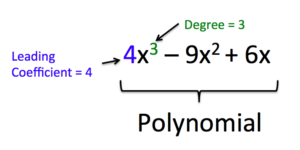Learning Outcomes
- Identify a polynomial
- Evaluate a polynomial for given values
A polynomial is an expression consisting of a sum or difference of terms in which each term consists of a real number, a variable, or the product of a real number and one or more variables with non-negative integer exponents. Non negative integers are [latex]0, 1, 2, 3, 4[/latex], …
Identify a polynomial
The following table is intended to help you tell the difference between what is a polynomial and what is not.
| IS a Polynomial | Is NOT a Polynomial | Because |
| [latex]2x^2-\frac{1}{2}x -9[/latex] | [latex]\frac{2}{x^{2}}+x[/latex] | Polynomials only have variables in the numerator |
| [latex]\frac{y}{4}-y^3[/latex] | [latex]\frac{2}{y}+4[/latex] | Polynomials only have variables in the numerator |
| [latex]\sqrt{12}\left(a\right)+9[/latex] | [latex]\sqrt{a}+7[/latex] | Roots are equivalent to rational exponents, and polynomials only have integer exponents |
The basic building block of a polynomial is a monomial. A monomial is one term and can be a number, a variable, or the product of a number and variables with an exponent. The number part of the term is called the coefficient.

A polynomial containing two terms, such as [latex]2x - 9[/latex], is called a binomial. A polynomial containing three terms, such as [latex]-3{x}^{2}+8x - 7[/latex], is called a trinomial.
We can find the degree of a polynomial by identifying the highest power of the variable that occurs in the polynomial. The term with the highest degree is called the leading term because it is usually written first. The coefficient of the leading term is called the leading coefficient. When a polynomial is written so that the powers are descending, we say that it is in standard form. It is important to note that polynomials only have integer exponents.

Example
Which of the following expressions is a polynomial? Select all that apply.
-
- [latex]-\frac{1}{12}{x}^{3}+5+2{x}^{2}[/latex]
- [latex]5{x}^{\frac{1}{2}}-2{x}^{3}+7x[/latex]
- [latex]7p-{p}^{11}-1[/latex]
- [latex]{x}^{-1}+{x}^{3}-9[/latex]
The table below illustrates some examples of monomials, binomials, trinomials, and other polynomials. They are all written in standard form.
| Monomials | Binomials | Trinomials | Other Polynomials |
| [latex]15[/latex] | [latex]3y+13[/latex] | [latex]x^{3}-x^{2}+1[/latex] | [latex]5x^{4}+3x^{3}-6x^{2}+2x[/latex] |
| [latex]\displaystyle \frac{1}{2}x[/latex] | [latex]4p-7[/latex] | [latex]3x^{2}+2x-9[/latex] | [latex]\frac{1}{3}x^{5}-2x^{4}+\frac{2}{9}x^{3}-x^{2}+4x-\frac{5}{6}[/latex] |
| [latex]-4y^{3}[/latex] | [latex]3x^{2}+\frac{5}{8}x[/latex] | [latex]3y^{3}+y^{2}-2[/latex] | [latex]3t^{3}-3t^{2}-3t-3[/latex] |
| [latex]16n^{4}[/latex] | [latex]14y^{3}+3y[/latex] | [latex]a^{7}+2a^{5}-3a^{3}[/latex] | [latex]q^{7}+2q^{5}-3q^{3}+q[/latex] |
When the coefficient of a polynomial term is [latex]0[/latex], you usually do not write the term at all (because [latex]0[/latex] times anything is [latex]0[/latex], and adding [latex]0[/latex] doesn’t change the value). The last binomial above could be written as a trinomial, [latex]14y^{3}+0y^{2}+3y[/latex].
A term without a variable is called a constant term, and the degree of that term is [latex]0[/latex]. For example [latex]13[/latex] is the constant term in [latex]3y+13[/latex]. You would usually say that [latex]14y^{3}+3y[/latex] has no constant term or that the constant term is [latex]0[/latex].
The following video illustrates how to identify which expressions are polynomials.
Evaluate a polynomial
You can evaluate polynomials just as you can other kinds of expressions. To evaluate an expression for a value of the variable, you substitute the value for the variable every time it appears. Then use the order of operations to find the resulting value for the expression.
Example
Evaluate [latex]3x^{2}-2x+1[/latex] for [latex]x=-1[/latex].
Example
Evaluate [latex]\displaystyle -\frac{2}{3}p^{4}+2p^{3}-p[/latex] for [latex]p = 3[/latex].
In the following video we show more examples of evaluating polynomials for given values of the variable.
Candela Citations
- Evaluate a Polynomial in One Variable. Authored by: James Souse (Mathispower4u.com). Located at: https://youtu.be/2EeFrgQP1hM. License: CC BY: Attribution
- Revision and Adaptation. Provided by: Lumen Learning. License: CC BY: Attribution
- Unit 11: Exponents and Polynomials, from Developmental Math: An Open Program. Provided by: Monterey Institute of Technology. Located at: http://nrocnetwork.org/dm-opentext. License: CC BY: Attribution
- College Algebra. Authored by: Abramson, Jay, et al.. Located at: http://cnx.org/contents/9b08c294-057f-4201-9f48-5d6ad992740d@3.278:1/Preface. License: Public Domain: No Known Copyright. License Terms: Download for free at :http://cnx.org/contents/9b08c294-057f-4201-9f48-5d6ad992740d@3.278:1/Preface
